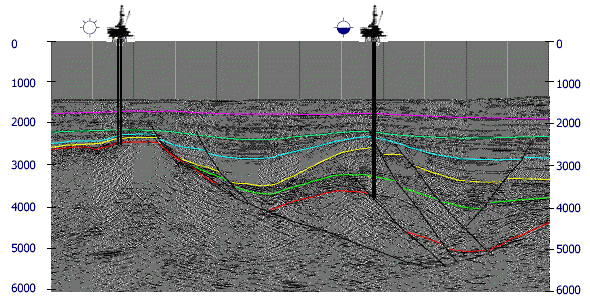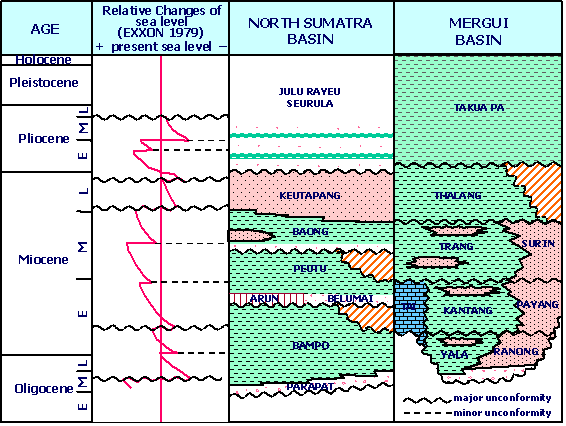| |
Thailand
Petroleum Provinces |
| |
Petroleum
provinces in Thailand can be geographically separated
into six regions, the Northern Thailand, the Central Plain,
the Northeastern Thailand, Southern Thailand, the Gulf
of Thailand and the Andaman Sea. Petroliferous basins
are mostly Tertiary in age and distributed in various
parts of the country, both onshore and offshore. Ten Tertiary
basins are assured their petroleum systems to yield commercial
hydrocarbon. Pre-Tertiary basin located in
the northeast is made up of sedimentary rocks dating from
Carboniferous to Tertiary. Hydrocarbon deposits have been
found and currently produced from Permian strata. |
| |
Sedimentary basins in Thailand
|
| |
|
| |
|
| |
|
| |
Northern
Intermontane Basin |
| |
The
area is bounded to the south by the Uttaradit Fault Zone
and its assumed south westward projection. The area consists
of ten intermontane Tertiary basins of various
sizes. The basins were formed as a series of pull apart
basins of mainly north-south trending half grabens. Basins
are generally narrow but deep and occasionally emit an
abnormal high heat flow. The exploration is intensively
carried out in the Fang area whereas for the other parts,
works are very limited. |
| |
Since
the discovery of the first oilfield, Chai Prakan in the
Fang Basin 50 years ago, a number of marginal oilfields
were subsequently discovered. Petroleum is produced from fluvio-lacustrine sandstones which are sealed and sourced
by lacustrine shales of similar age. A variety of structural
traps are present, such as antithetic and synthetic faults,
rollover anticline and normal fault. Oil shows from well
penetrating Triassic sandstone basement does not rule
out the possibility of finding hydrocarbon in pre-Tertiary
rocks in the area.
|
| |
Seven
blocks are reserved and under the supervision of Department
of Defense. These blocks cover Fang, Chiang Mai, Lampang,
Phare, Chiang Rai and Payoa Basins. Five blocks delineated
by the Department of Mineral Resources are available for
bid in the area covering Mae Sod, Pua and Nan Basins.
The first seismic survey acquired in 1997 over Mae Sod
basin reveal the subsurface structure of the basin. Thick
oil shale strata observed from outcrop and shallow wells
are evident to the presence of excellent source rock in
the area. Petroleum system in these basins is expected
to be similar to Fang Basin.
|
| |
|
| |
Seismic Section over the Mae Sod Basin
|
| |
|
| |
|
| |
|
| |
Central
Plain |
| |
This
region consists of a number of north-south trending half
grabens formed by conjugate transtensional shear during
early Tertiary. A number of oil fields have been discovered
in the Phitsanulok, Suphan Buri, Kamphaeng Saen and Petchabun
Basins. The Phitsanulok, the largest basin, is filled
up with 8 km of sediments. Ten oil fields have been discovered
in the basin. Hydrocarbons are mainly produced from Oligocene-Miocene
fluvio-lacustrine sandstone. However, a significant amount
of oil produced from fractured and weathered pre-Tertiary
granites are continually increasing. |
| |
The
principal reservoir rocks in the area are sandstone of
Miocene age. Source and seal are provided by Miocene lacustrine
shales. A variety of play types exist including rollover,
faulted anticline, tilted blocks, stratigraphic pinch-out
and buried hill. |
| |
A
large number of blocks are available for bid throughout
the Central Plain. A number of untested prospects were
left in surrounding area of existing concessions. Traces
of very light oil found in vuggy Permian limestone south
of Phitsanulok basin is a guide to the possibility of
finding hydrocarbon in pre-Tertiary rock in this region. |
| |
|
| |
Seismic Cross-section of Suphan Buri Basin
|
| |
|
| |
|
| |
|
| |
Khorat
Plateau and Nakhon Thai High |
| |
The
Khorat Plateau named as a geographical entity covers an
area of approximately 200,000 km2, occupying almost the
entire northeast Thailand region. The Khorat Plateau is
underlain by Permo-Carboniferous, Triassic, Mesozoic and
Tertiary basins. These complex sets of basins formed by
several plate collisions and subsequent extensions during
four different periods, from middle Paleozoic to Tertiary.
The Permo-Carboniferous sequences consist of shallow marine
siliclastic and carbonate sediments. During Late Triassic,
a series of half-graben basins developed sporadically.
The Triassic sequences are mainly lacustrine and fluviatile
clastic sediments. After uplift and erosion in latest
Triassic, the region subsided and subsequently overlain
by thick non-marine Mesozoic Redbeds. The Tertiary sediments,
consisting of Aeolian and alluvial deposits, are local
in extent and relatively thin. |
| |
Permian
carbonate is the gas-bearing reservoir whereas Permian
shale and Triassic organic rich shales are potential source
rocks. Secondary porosity from dolomitization and fracture
enhance the reservoir quality and being the key factor
for increasing the productivity. Long period of complex
tectonic evolution resulted in a variety of structural
and stratigraphic configurations which provide favorable
conditions for hydrocarbon accumulation. Three significant
gas fields were discovered. Apart from the established
plays which are unconformity-related-carbonates, the Khorat
Plateau still contains significant plays and prospects
which have not yet been fully explored. Recent seismic
data in the frontier area along the southern rim of Khorat
Plateau and Nakhon Thai High reveals a hidden Permian
structure which has been overlooked in the past and waiting
to be investigated. Virtually all of Northeastern Thailand
is available for licensing. |
| |
|
| |
Schematic
Cross-section and Play Type of Khorat Plateau
|
| |
|
| |
|
| |
|
| |
Southern Plain |
| |
Few small basins containing Tertiary strata exist in the
onshore southern area. The largest basin is the Khien Sa
Basin. The exploration within this region has not yet been
successful. Two wells were drilled to test hydrocarbon
accumulation in Tertiary strata of Khian Sa Basin. The
result were not encouraging. However, oil stains found in
Middle Jurassic shales and sandstones indicate some
hydrocarbon potential of older sediments in the area. In
addition, the discovery of Nang Nuan oilfield in Chumporn
Basin to the north which is a buried hill play of Permian
carbonate reservoir bring to the possibility of finding
hydrocarbon in the pre-Tertiary rocks and should be the
target for the future exploration in this area. Not many
subsurface information are available and little is known
about the hydrocarbon potential of the under explored
Southern Thailand. Five blocks are available for bid. |
| |
|
| |
^Top |
| |
Gulf of Thailand |
| |
The majority of petroleum produced in Thailand comes from
offshore Tertiary basins in the Gulf of Thailand. The Ko
Kra Ridge splits the Gulf into two parts. The western
portion contains ten main basins of various sizes.
Discoveries have been made in Chumporn and Songkhla
Basins. The eastern part is composed of Pattani, Khmer and
Malay Basin. Pattani and Malay are hydrocarbon prolific
basins. Sediments are non-marine in origin, mainly
fluvio-lacustrine deposits. However, the eastern portion
was influenced by marine incursion during the early
Miocene age. Hydrocarbons are found in Oligocene and
Miocene sandstones. Source rocks are of Oligocene and
Miocene sediments. The Oligocene sources are oil-prone
source rocks which contains Type I kerogen. The Miocene
sources are fluvial flood plain and delta plain sediments
which mainly consists of Type III kerogen and tend to
yield gas. A variety of trap types present in the Gulf
such as anticlinal faults, tilted faults, rollover and
buried hills. A number of oil and gas fields have been
found in Pattani and North Malay Basin. Most of the gas
fields are distributed all over the central part of the
Pattani basin while oil fields are gathered in the
shallower part of the basin margin. Blocks are available
for bid throughout the Gulf particularly in the northern
and southern portions. |
| |
|
| |
Seismic
Cross-Section of the Songkhla Basin |
| |
 |
| |
|
| |
^Top |
| |
Andaman Sea |
| |
The Andaman Sea is located in the western Thailand. The
region is divided into two parts by shelf margin, the
shallow and deep water parts. The Mergui, the
transtensional back arc basin, is situated mainly in the
deep water. The basin is the northern extension of North
Sumatra Basin. The Mergui Basin is the only one Tertiary
basin of which sediments are truly marine origin. Two
un-appraised gas prospects have been found and several gas
show were encountered in the Oligocene sandstones. Early
Miocene sandstones and carbonate build-ups formed on the
horst and shelf margin are excellent in quality and would
be potential reservoirs. Oligocene and Early Miocene
shales with landplant-derived organic matters are
potential source rocks. However, matured source rocks are
mainly restricted in the deep part of the basin. A variety
of play types can be found both structurally and
stratigraphically. A number of structural traps presented
are related to extensional and transtensional tectonics.
The untested stratigraphic plays of Middle Miocene
turbiditic sandstone and pinch-out of Oligocene sandstone
against basement are the prime target for future
exploration. Three shallow water blocks and one deep water
block are available for bid. |
| |
|
| |
Seismic
Cross-Section of the Mergui Basin |
| |
 |
| |
|
| |
Stratigraphy of the Mergui Basin |
| |
 |
| |
|
| |
^Top |


